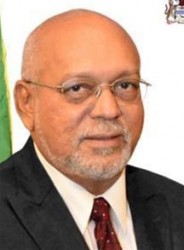President Donald Ramotar says that the majority of the $6.6 billion allocated to the Guyana Sugar Corporation in the 2014 budget will go directly into mechanization.
Speaking at a press conference on Thursday at the Office of the President, he stated that the money budgeted for GuySuCo will have to be spent on changing the physical layout of the fields, preparing for further machine-friendly harvesting. He noted that the fact of the declining labour force could not be denied.
Ramotar stated that “all over the industry, I don’t think there is any one of the estates where

you can talk about an 80 percent turnout” while highlighting that on the West Coast estate, Uitvlugt, worker turnout was on average 43 percent.
The President painted a grim picture for the sugar sector by also highlighting the decline in the global price for sugar over the years. Sugar prices were 16.66 US cents per pound at the end of February, 2014 this decline has been ongoing since July of 2011 when sugar prices were just over 29 US cents per pound.
In conjunction with Guyana’s sluggish production, sugar will continue to be a struggling sector unless major rehabilitation to the lands and factories are actually done and not just talked about, observers say.
The $6.6 billion budgeted for GuySuCo would barely cover the cash deficit the state-owned corporation is currently saddled with, over $5 billion. Ramotar failed to mention that last year’s $1 billion GuySuCo allocation went primarily to paying outstanding wages and that the amount was not anywhere near enough with over 18,000 employees on the payroll.
Since 2007, the European Union (EU) has been providing Guyana with monies under the accompanying measures that were crafted following the reform of the EU’s sugar regime. These reforms had led to a slashing of the price paid by the EU for sugar from the ACP countries by 36%. The accompanying measures had been intended to cushion the impact of this on the sugar industries in ACP countries. In recent months, the main sugar union GAWU and others have questioned whether all of the money from the EU has been put into GuySuCo. Finance Minister Dr Ashni Singh addressed this matter in his budget presentation on Monday. He said that “… particularly given the public debate on this issue, it is useful to indicate that Government transferred a total of US$195 million to GUYSUCO over the period from 2005 to 2013 in support of its various restructuring and turnaround initiatives. This exceeds the total of €110.1 million equivalent to US$145.9 million received from the EU under the accompanying measures programme since its introduction.
Critics however say that although the finance minister is stating that this amount was given to the state owned entity there has been little to show for this money and even less to show in terms of a financial breakdown of where exactly the money was spent over the years.
As part of the accompanying measures, the EU has been assisting the sugar industry through project-based funding but given the extensive needs at GuySuCo, budget support was seen as a more viable option. The EU measures Guyana’s sugar success annually and the move away from project-based funding requires GuySuco to meet certain benchmarks.
In June of 2013 when Ambassador Robert Kopecky of the EU and Finance Minister Singh met, the EU made it clear that GuySuCo was lagging in mechanisation and that budgetary support could be reduced if the state-owed corporation did not do more. This may explain the present focus on mechanisation in the budget.
The sugar company subsequently compiled its 2013-2017 Strategic Plan focusing heavily on field evaluation but neglected to say just how the agronomy was to be looked at. The Plan was subsequently revealed in October of 2013 to the public. Glaring omissions from the plan included how much would be spent on the acquisition of more mechanical harvesters.
The changing weather patterns have made opportunity days for the sugar industry few and far between. President Ramotar stressed that there has been a considerable reduction in the number of days harvesting is possible. Paired with the declining labour force more harvesters are needed to accomplish the work in the time period.
During his budget speech Singh stated that sugar’s contribution to Guyana’s GDP was US$112.2 million in 2013 however this was an almost 16 percent decline from 2012 where sugar exports were over US$ 132.1 million according to the Bureau of Statistics.
He noted that sugar survival depended on diversification.




